The Shakespeare of shoehorns: Shoddy Goods 044
2
If you’ve been reading Shoddy Goods, the newsletter from Meh about the stories behind consumer culture, you know I’m a sucker for finding the magic in the mundane. I’m Jason Toon and my subject this week cranks up both the mundanity and the magic.
I don’t spend a lot of time thinking about shoehorns. You probably don’t either. Fortunately for succeeding generations, Robart Hendart Mindum did.
As the 16th century turned into the 17th, Mindum was a prolific engraver of shoehorns out of white ox-horn (hence the name, which I never realized either). There are currently 28 known Mindum shoehorns, plus a couple of powderhorns. All his designs feature dense Elizabethan decorative motifs: Tudor roses, crowns, scrollwork, scales, geometric bands. Most charmingly, every Mindum “shoing horne” is also inscribed with the names of people he carved them for, indicating that they were gifts.
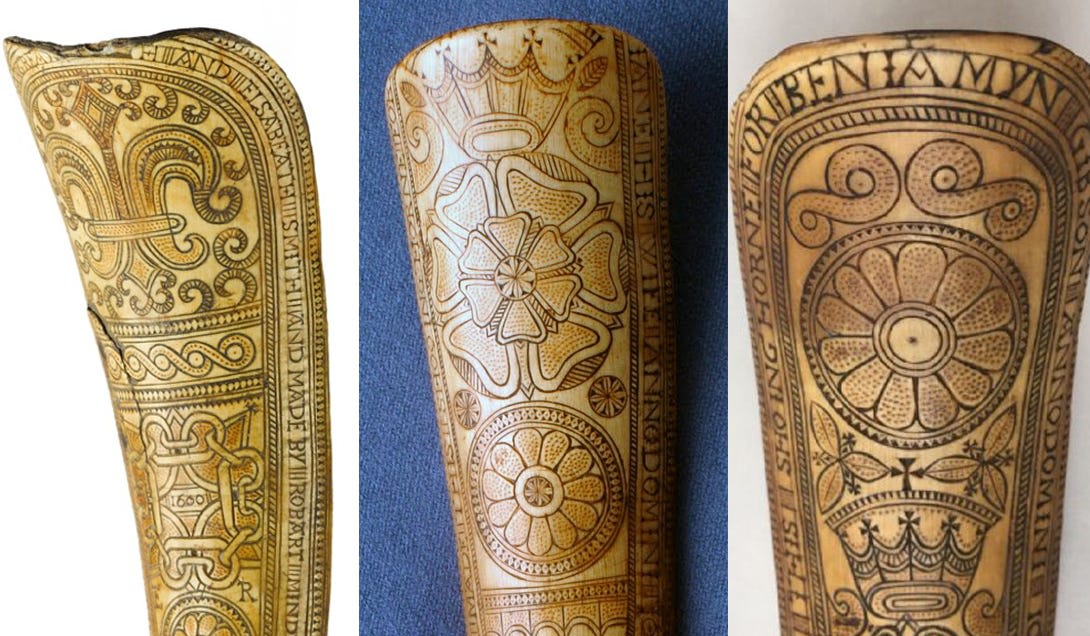
You guys, I think I love shoehorns now…?
When you care enough to carve the very best
OK, to the modern sensibility, a shoehorn is the very model of an underwhelming present. Sure, it comes in handy getting into tight shoes, but as a gift? It’s a lame sitcom joke that a shlubby, clueless husband would give his long-suffering wife, or a heartless corporation to its employees in lieu of a Christmas bonus (back when Christmas bonuses were a thing).
Not so in England circa 1600. First of all, people just had less stuff. Surviving inventories of personal possessions show that even successful merchants could’ve fit their household goods into a storage pod. Nobody would turn up their nose at a useful, durable utensil that was also ornately decorated.
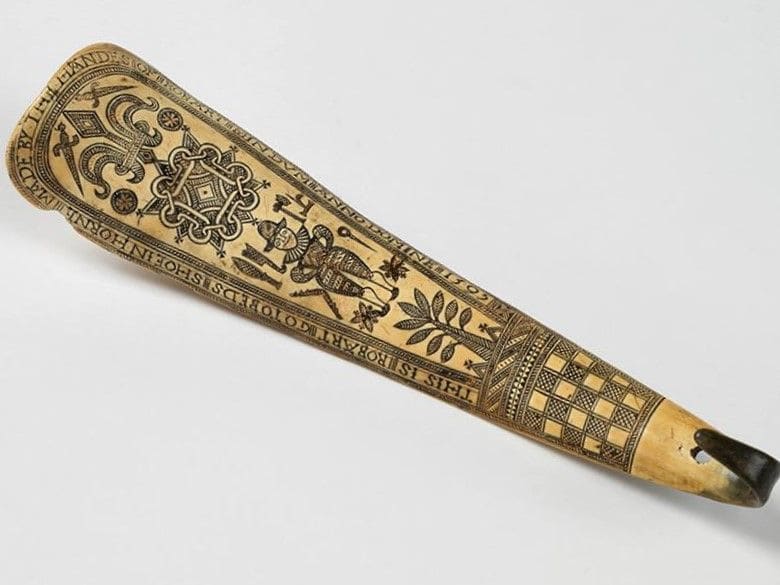
For the implausibly named Robart Gotobed, 1595, not to be confused with the punk rock drummer.
In particular, shoehorns were so hot right then. In Renaissance Europe, as footwear got more elaborate and stiffer than its medieval predecessors, along came the shoehorn, possibly from China. Queen Elizabeth, the top influencer of her day, made shoehorns go viral when she started giving them as gifts. The Shoehorn Museum (yes, it’s real) says that while these royal shoehorns were among the first to be made from metal, more common were those made from scrimshaw, ivory, and animal horn.
We don’t do much with it now, but horn was a versatile, plentiful, and aesthetically pleasing staple of pre-modern material culture. Horner’s Guilds sprung up in major cities in the 1300s, developing techniques to mold heated animal horn into anything from combs to spectacles - both items that show their organic origins in their modern plastic “tortoiseshell” incarnations. Its translucence lent itself to lantern shades and even windowpanes. And did you ever wonder where the last name Horner came from? (I admit, I didn’t.)
In the centuries before synthetic plastic, animal horn and tortoiseshell were “natural plastics”. Which makes Mindum’s shoehorns seem a little closer to a modern giveaway shoehorn that might have your podiatrist’s website address printed on it, but a lot prettier.
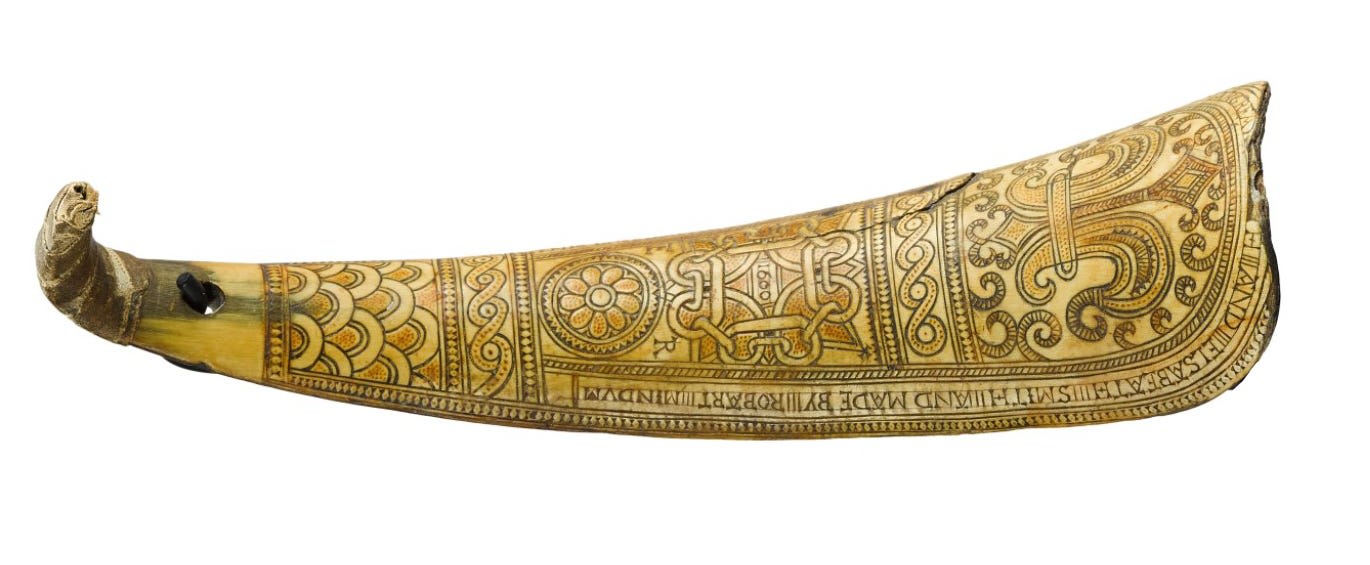
Looks like a certain Francis Hinson started the 1600s off right.
By his shoehorns shall ye know him
So who was Robart Mindum? Almost everything we know, we know from his shoehorns. Thanks to the dates and inscriptions, we know he was carving shoehorns from 1593 to 1613. We know his wife’s name was Jane, and we know the names of some of his associates, some of whom have left traces in the historical record. So we can also be reasonably sure he was working in or near the county of Cambridgeshire, England, where the people he know were concentrated.
Beyond that lie only theories. Was he a professional horner? That would be the natural assumption. But he doesn’t appear in any guild records of then time. The horns themselves seem to have been crafted differently enough that they might not be the work of one person. Then there’s the fact that all of Mindum’s surviving hornwork appears to be gifts. That has led some historians to conclude that he was probably an enthusiastic hobbyist, engraving his designs into pre-worked shoehorns.
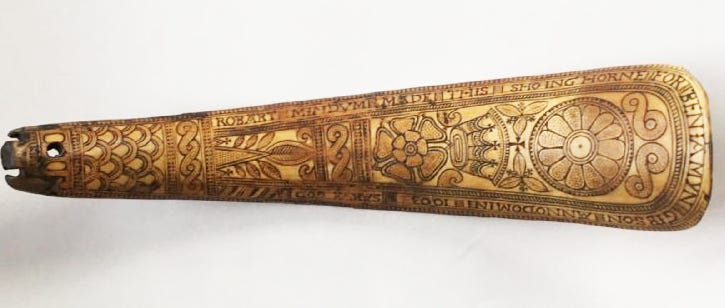
Beniamyn Gibson got a shoehorn as cool as the way he spelled his name, 1603.
There’s no bigger Mindum obsessive than Wayne Robinson, who blogs as The Leatherworking Reverend and wrote the invaluable paper The Opus of Robert Mindum. On his blog, Robinson advances a pretty convincing case that Mindum probably worked in “publishing, possibly preparing woodcut blocks.” Some of this gets into carving arcana that’s well beyond me. But it seems Mindum’s trademark moves - varied line weights, the use of compasses and construction lines, some of his decorative elements - are almost unknown in other contemporary hornwork, but common in books of the time.
Robinson’s most piquant observation, though, is that Mindum gets a digit backward in one of his date inscriptions.“Really, the only sort of person who would make this kind of mistake is one who is used to carving letters and/or numbers backwards all the time,” Robinson writes. He imagines Mindum “in that Zen state professional craftspeople achieve, just about finished the latest shoe horn, having a moment’s lapse and carving the number backwards, just as he does all day when preparing blocks for press. ‘Oh bugger it,’ he thinks, ‘no one will ever notice.’”
It’s a touchingly human image, in keeping with the humanity embodied in Mindum’s shoehorns - and in his own story, or lack of it. It would be another 250 years before some of his pieces started to be catalogued by collectors, and “Mindum shoehorn” has only been a byword for collectors since the mid-20th century. Newly discovered Mindum shoehorns still turn up, most recently in 2023. Almost every trace of his life has been lost; it’s poignant how close this body of work came to being forgotten, too.
To me, the most moving fact is that one of Mindum’s finest pieces, showing a particularly high degree of craft and care, is the one he gave his wife Jane in 1613. Then as now, if you’re gonna give your wife a shoehorn, it better be a damn good one.
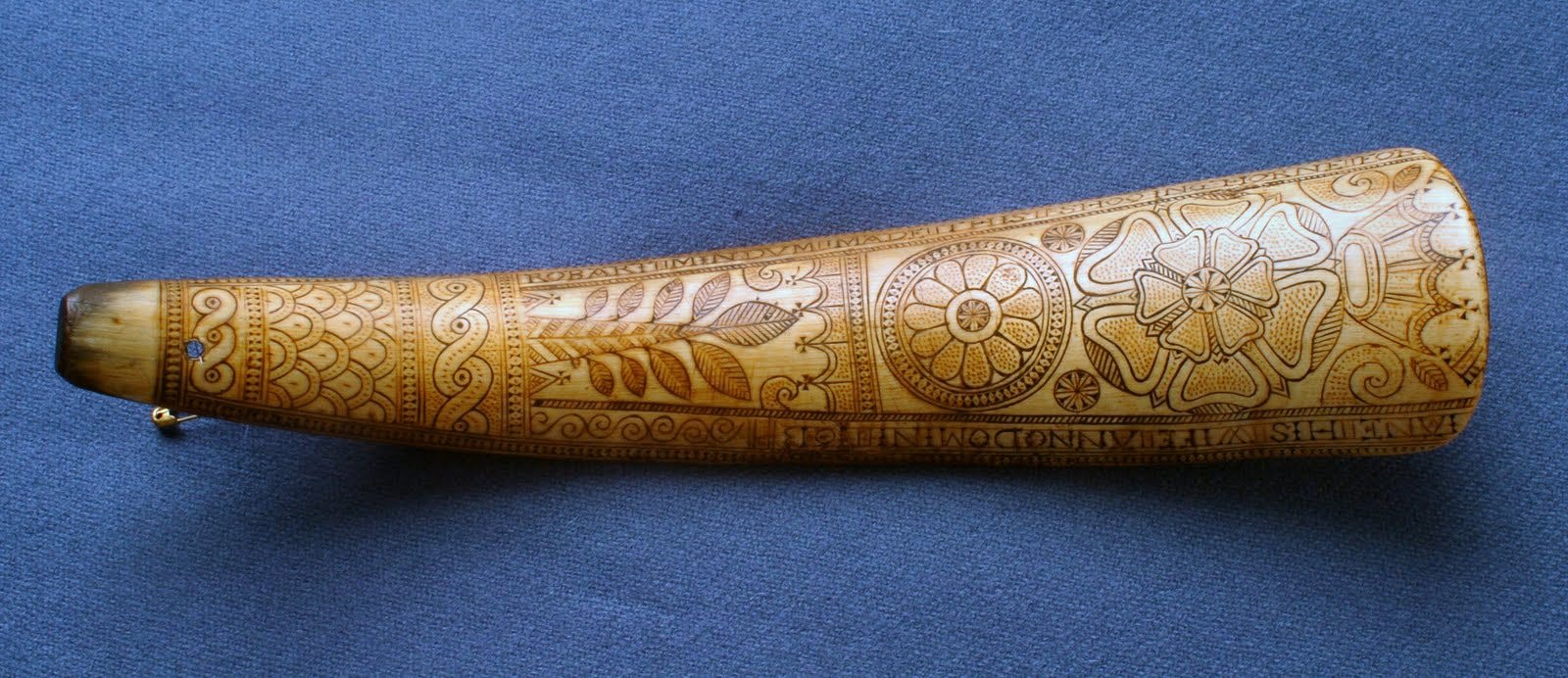
Love is a lavishly engraved shoehorn.
I remember in high school a bunch of us sitting around talking about nothing in particular when someone asked “Remember shoe horns? Geeze, when was the last time you used one of those” with all of us nodding in nostalgic memory of some long past time wedging a dress shoe on. But one of our pals chimed in with “…this morning? How else do you get your shoes on?” and our minds were blown.
So, uh, when was the last time you used a shoe horn? Let’s hear the wild stories in this week’s Shoddy Goods chat.
—Dave (and the rest of Meh)
If’t be true that mine account hath amus’d thee, hie thee hither to these various articles of olde:
- 15 comments
- Comment
I use one regularly - I have a pair of low-rise rubber boots that I slip on when it is wet outside (not uncommon in NW Oregon ). They are a snug fit and there is only a tiny tab at the heel, so I bought a long handled shoe horn to make donning them quick and easy. Works for me.
). They are a snug fit and there is only a tiny tab at the heel, so I bought a long handled shoe horn to make donning them quick and easy. Works for me.
The 99 Cents Only stores closed and Dollar (and a quarter) Tree doesn’t have the same selection.
Anyone who has ever had to pour their feet into well made boots would appreciate both a good shoe horn, boot hooks and/or boot blocks.
I remember back in the SCA days of my youth, having to wear boots in muddy war times and needing all the help you could get to shove your feet into them by the 3rd day and of course get them off
I use a back scratcher ALL the time, long shoe horns occasionally, and fly swatters once in a while.
All I can think of is this. Sadly, the embedded link won’t start at the time I put in, so skip ahead to 3 minutes.
growing up, our household had one made of water buffalo horn - we all used it. i still have it although the end that has the back scratcher shaped like a hand has broken off (i have taped it together). i also got a long-handed metal one (for putting on shoes while standing) that i got from amazon which i use every day. i also have two bamboo back scratchers, one at my desk and one in the bedroom. AND i have three fly swatters - one in the kitchen, one in the bathroom and one outside in the patio - they are rarely used but i have them in case i need them LOL… my brother has two shoe horns in his house - i am there every weekend so i use them. AND i gifted one to a friend who recently had back surgery.
I use a shoe horn every day. There are several scattered around my house so that one will always be handy in any spot where I might be putting on shoes. I even have one in my travel shaving bag so that I have one with me when I’m on the road. One of those great inventions (like the hammer) that there’s probably no way to improve upon
Just realizing I could use a shoehorn. One of my shoes (just the one foot) is a PITA to put on, and it kills the heels of my socks.
I’ll add it to my Amazon order.
Has no one else pondered whether ‘The Shakespeare of shoehorns’ might be the Shakespeare of playwrights, as well? The dates on the shoehorns overlap very nicely with Shakespeare’s adulthood. After an exasperating day, trying to come up with dialog for Hamlet, wouldn’t the Bard have loved to relax with a little shoehorn engraving?
My go-to favorite shoehorn is an 18" souvenir of a visit to the San Antonio Shoe company store.
We rely on our shoe horns and back scratchers 'round here. Fly swatters not so much, but on the rare occasion a fly is stupid enough to flunder into our house, I grab that thing that looks like a tennis racket and has a battery in it. The first time I showed that to my husband, he said “Oh come on, this is a gimmick. No way this will ow.”
Bought one for, IIRC, sports shoes for our kids and they were all completely baffled by every aspect of it. Showed them a couple times and then they never used it. That said, I also never used it and can’t remember the last time I did use one (I’m 45).
I use a long-handled shoe horn from Ikea on a regular basis. Some boots need it, and I’m also a philistine who rarely unties/unbuckles shoes, so the shoehorn keeps me from collapsing the heels
I love the story about Robart Hendart Mindum. I want to think he was a woodblock carver. I’ve carved printing blocks and messed up the opposite way, as well as set type upside down, etc. Those carvings are beautiful!
I’ve been thinking a lot lately about mundane wonders—amazing aspects of our daily life that we don’t appreciate because they’ve become commonplace. And so today (like four months after this was written) I have come to more fully appreciate the fact that my life basically never requires me to wear a shoe that even moderately requires a shoe horn.